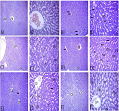In vivo study of the antioxidant test of ethanolic extract of Chromolaena odorata Linn. leaves

Downloads
Additional Files
Background: Chromolaena odorata L. leaf was reported to contain phenolic group compounds, such as flavonoids. Flavonoid compounds have been reported to have antioxidant activity. Based on in vitro study, Chromolaena odorata L. leaves have potent antioxidant activity. However, in vivo, studies with dose variations have not been reported.
Purpose: This study evaluates the antioxidant activity with various doses of ethanolic extract of Chromolaena odorata L. leaves against male Wistar rats induced by paracetamol.
Methods: Flavonoid contents were measured spectrophotometrically based on the formation of a complex flavonoid-aluminum. Quercetin was used to make a calibration curve. In vivo test was used TBARS method carried out by measured malondialdehyde (MDA) level in male Wistar rats induced by paracetamol 2g/Kg BW. The test was carried out on extracts with doses of 125, 250, and 500 mg/Kg BW. Vitamin C with dose 6,5mg/Kg BW used as a positive control, and 1% of Na CMC used as the negative control. Histopathology assessment of liver used Hema-toxylin Eosin Stain.
Results: Ethanolic extract of Chromolaena odorata L. leaves contain flavonoid 126.459±0.163 mg/g extract as quercetin equivalent. Intoxication paracetamol on rats increased MDA serum level significantly different (p-value < 0.005) with normal control. Treatment of ascorbic acid and extracts decreased MDA serum level significantly different (p-value < 0.005) with control negative and improved the histological structure of hepatocytes.
Conclusion: Ethanolic extract of Chromolaena odorata Linn. dose 500 mg/Kg BW was the best treatment with exhibited 58.974% reduction of MDA serum level and better improve the histological structure hepatocytes than other doses
Authors retain copyright and grant the journal right of first publication with the work simultaneously licensed under a Creative Commons Attribution-NonCommercial 4.0 International License that allows others to share the work with an acknowledgement of the work's authorship and initial publication in this journal.
Authors are able to enter into separate, additional contractual arrangements for the non-exclusive distribution of the journal's published version of the work (e.g., post it to an institutional repository or publish it in a book), with an acknowledgement of its initial publication in this journal.
Authors are permitted and encouraged to post their work online (e.g., in institutional repositories or on their website) prior to and during the submission process, as it can lead to productive exchanges, as well as earlier and greater citation of published work (See The Effect of Open Access).

This work is licensed under a Creative Commons Attribution-NonCommercial 4.0 International License.











